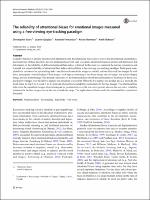Please use this identifier to cite or link to this item:
https://hdl.handle.net/20.500.12202/10074| Title: | The reliability of attentional biases for emotional images measured using a free-viewing eye-tracking paradigm |
| Authors: | Sears, Christopher Quigley, Leanne Fernandez, Amanda Newman, Kristin Dobson, Keith 0000-0002-3676-4083 |
| Keywords: | Attentional bias Eye tracking Reliability Test-retest |
| Issue Date: | 22-Oct-2018 |
| Publisher: | Springer US |
| Citation: | Sears, C. R., Quigley, L., Fernandez, A., Newman, K. R., & Dobson, K. S. (2019). The reliability of attentional biases for emotional images measured using a free-viewing eye-tracking paradigm. Behavior Research Methods, 51, 2748-2760. doi:10.3758/s13428-018-1147-z |
| Series/Report no.: | Behavior Research Methods;51 |
| Abstract: | Cognitive theories of anxiety disorders and depression posit that attentional biases play a role in the development, maintenance, and recurrence of these disorders. Several paradigms have been used to examine attentional biases in anxiety and depression, but information on the reliability of different attentional bias indices is limited. In this study we examined the internal consistency and 6-month test–retest reliability of attentional bias indices derived from a free-viewing eye-tracking paradigm. Participants completed two versions of an eye-tracking task—one that used naturalistic images as stimuli, and one that used face images. In both tasks, participants viewed displays of four images, each display consisting of one threat image, one sad image, one positive/happy image, and one neutral image. The internal consistency of the fixation indices (dwell time and number of fixations) for threat, sad, and positive images over the full 8-s display was moderate to excellent. When the 8-s display was divided into 2-s intervals, the dwell times for the 0- to 2-s and 2- to 4-s intervals showed lower reliability, particularly for the face images. The attentional bias indices for the naturalistic images showed adequate to good stability over the test–retest period, whereas the test–retest reliability estimates for the face images were in the low to moderate range. The implications of these results for attentional bias research are discussed. |
| Description: | Research article / Open access |
| URI: | https://ezproxy.yu.edu/login?url=https://search.ebscohost.com/login.aspx?direct=true&AuthType=ip,sso&db=edssjs&AN=edssjs.2A9E2E0D&site=eds-live&scope=site https://hdl.handle.net/20.500.12202/10074 |
| ISSN: | 1554-3528 |
| Appears in Collections: | Ferkauf Graduate School of Psychology: Faculty Publications |
Files in This Item:
| File | Description | Size | Format | |
|---|---|---|---|---|
| Quigley 2019 OA The reliability.pdf | 608.5 kB | Adobe PDF |  View/Open |
This item is licensed under a Creative Commons License

